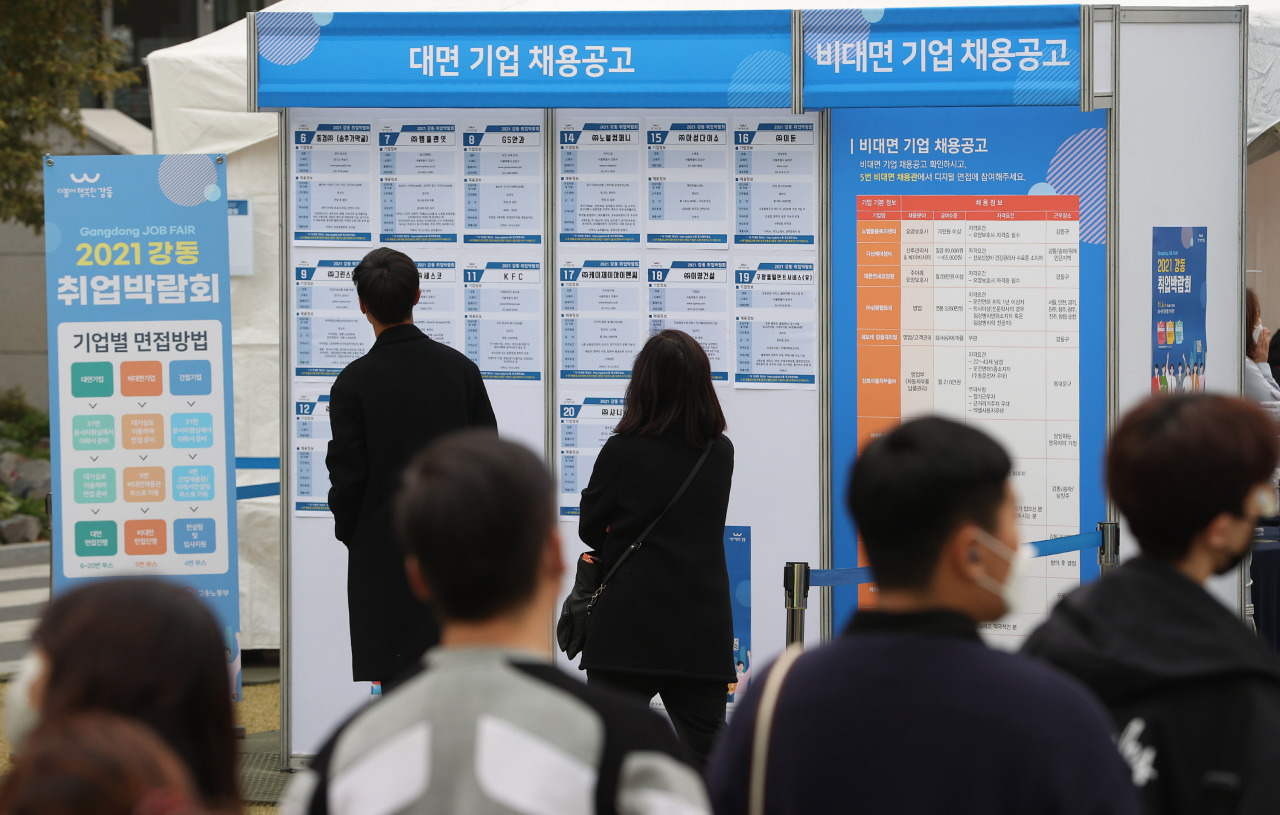 |
Jobseekers look at an employment information bulletin board at a job fair in eastern Seoul. (Yonhap) |
South Korea added the most jobs in seven years in 2021 as the job market recovered to pre-pandemic levels due to the base effect and the economic recovery, data showed Wednesday.
The number of employed people reached 27.27 million last year, 369,000 more than a year earlier, according to the data compiled by Statistics Korea.
It marked the largest number since 2014, when the nation reported an on-year increase of 598,000 jobs. Last year's number was higher than the government's earlier estimate of an increase of 350,000.
The 2021 reading compared with a fall of 218,000 in 2020, when the COVID-19 pandemic pummeled the country's job market. It was the largest job loss since 1998.
"The job market recovered last year due to the base effect, robust exports and changes in industrial structures, such as demand for contactless services and digitalization," Kong Mi-sook, a senior Statistics Korea official, told reporters.
In December last year, the number of employed people came to 27.29 million, 773,000 more than the previous year, the data showed. It marked the largest job addition in nearly eight years and the 10th consecutive month of job growth.
The job recovery has been extended even as the country is struggling to cope with the upsurge in COVID-19 cases and the fast spread of the omicron variant.
The number of unemployed people came to 1.04 million last year, down 71,000 from the previous year. That of jobless people fell 156,000 on-year to 979,000 in December.
The country's jobless rate for 2021 fell 0.3 percentage point to 3.7 percent. The unemployment rate declined 0.6 percentage point on-year to 3.5 percent in December.
The number of economically inactive people -- those who are neither working nor actively seeking jobs or people outside the labor force -- reached 16.77 million, down 3,000 from a year earlier. In December, the number of such people fell for the 10th straight month with an on-year fall of 327,000.
Despite the overall job recovery, in-person service segments, such as accommodations and retail, suffered job losses last year due to the fallout of the COVID-19 pandemic.
The number of employed people in the wholesale and retail sector fell 150,000 on-year, and the accommodation and restaurant segment reported a fall of 47,000.
The self-employed who hired workers declined 65,000 on-year in 2021, marking the third straight year of falls. The number of day laborers fell 96,000 on-year.
By age, the number of employed people aged 60 and older grew by the most with 330,000 on the back of state-arranged jobs. But those in their 30s and 40s declined by 107,000 and 35,000, respectively.
Asia's fourth-largest economy is on a recovery track on the back of robust exports. But the resurgence in COVID-19 cases is casting doubts on the recovery of private spending.
The finance ministry said it will keep close tabs on uncertainty in the job market as the country extended the strengthened social distancing rules in January.
Health authorities have imposed tighter antivirus measures since mid-December as the number of daily infections had soared to nearly 8,000 in the wake of the implementation of relaxed virus curbs under the "living with COVID-19" scheme.
The toughened antivirus restrictions, to be effective until Sunday, include a four-person cap on private gatherings across the nation and a 9 p.m. business hour curfew on cafes and restaurants.
South Korea added 4,388 new COVID-19 infections Wednesday, raising the total caseload to 674,868.
The Bank of Korea earlier forecast the number of employed people to increase 250,000 this year. The finance ministry puts the number of such people at 280,000 for 2022.
The country's central bank expects the South Korean economy to expand 3 percent this year after the estimated 4 percent growth last year. The government expects Asia's fourth-largest economy to grow 3.1 percent this year. (Yonhap)







![[Today’s K-pop] Blackpink’s Jennie, Lisa invited to Coachella as solo acts](http://res.heraldm.com/phpwas/restmb_idxmake.php?idx=644&simg=/content/image/2024/11/21/20241121050099_0.jpg)
